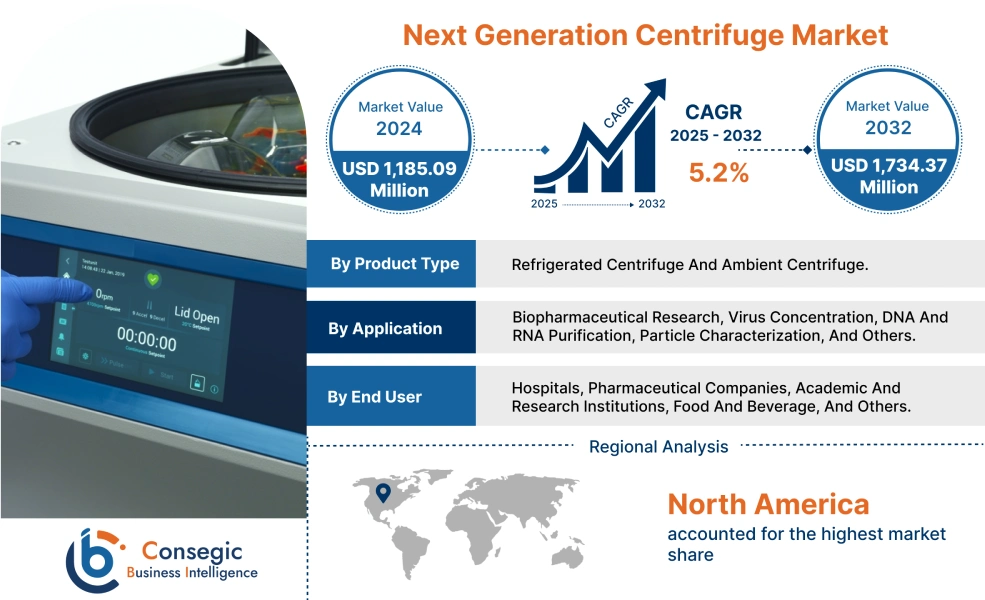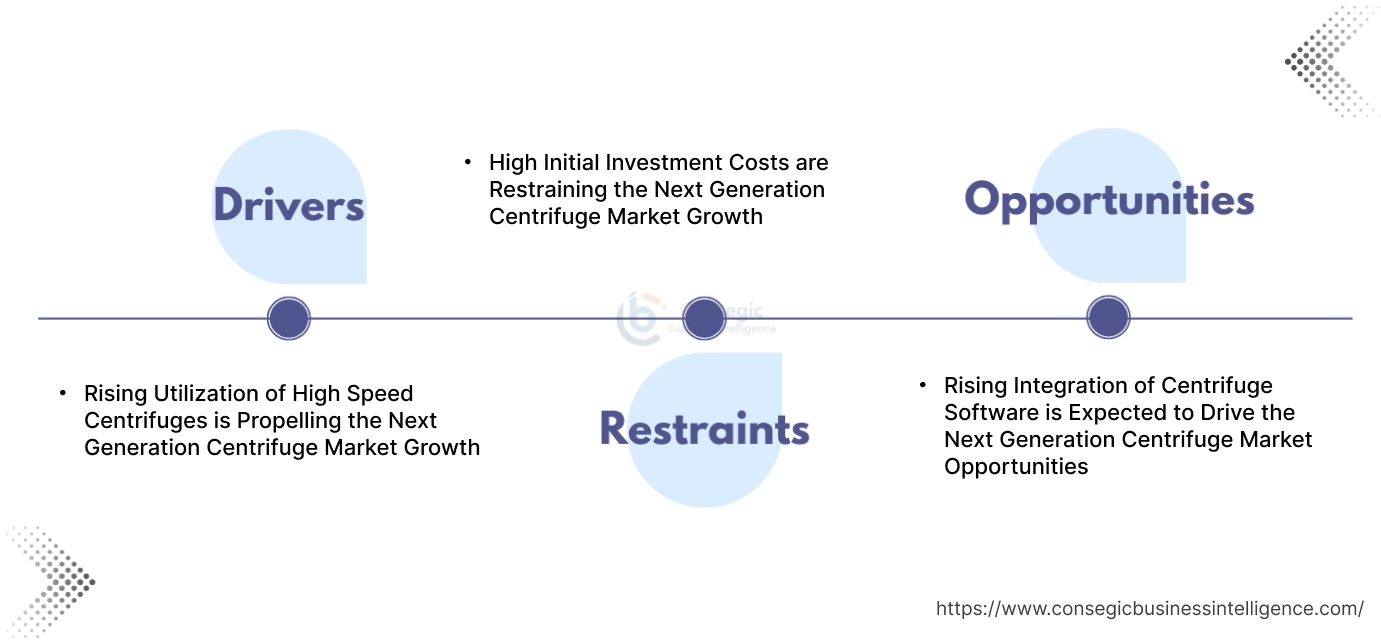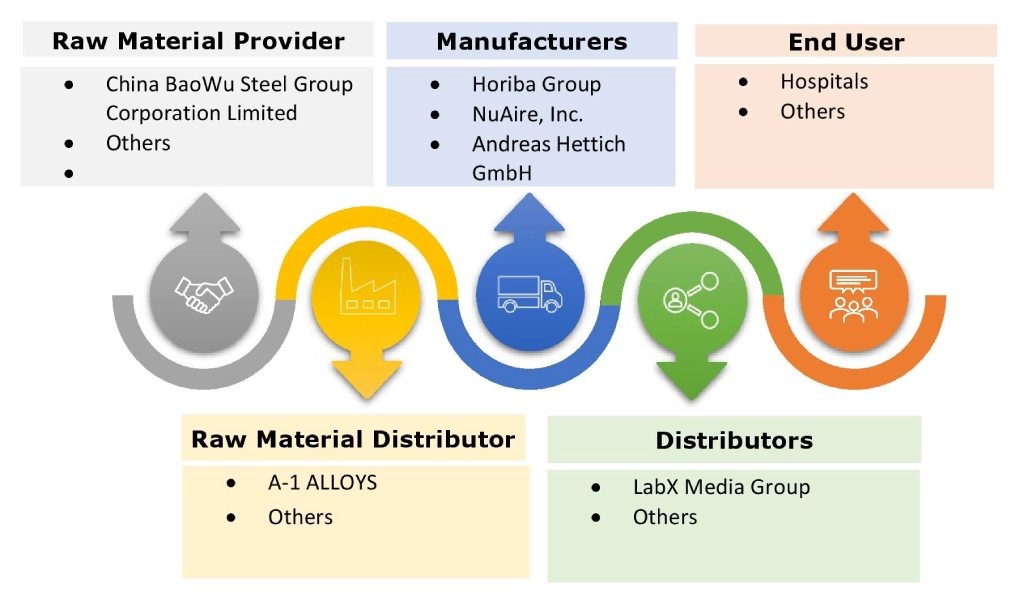Next Generation Centrifuge Market Size:
Next Generation Centrifuge Market size is estimated to reach over USD 1,734.37 Million by 2032 from a value of USD 1,185.09 Million in 2024 and is projected to grow by USD 1,222.25 Million in 2025, growing at a CAGR of 5.2% from 2025 to 2032.
Next Generation Centrifuge Market Scope & Overview:
Centrifugation is a technique that utilizes centrifugal force to separate components based on their density. Next generation centrifuge refers to advanced centrifuges that incorporate various features including automated workflows and microprocessor controlled operations. Further, the centrifuges offer improved speed, accuracy, and sample handling characteristics which has increased their adoption for protein purification and DNA extraction. Additionally, the centrifuges have better safety protocols compared to traditional centrifuges which drive the market. Moreover, rising adoption of touchscreen interfaces for easy access to the protocols and system checks in the centrifuges is also driving the market.
Next Generation Centrifuge Market Dynamics - (DRO) :
Key Drivers:
Rising Utilization of High Speed Centrifuges is Propelling the Next Generation Centrifuge Market Growth
High speed next gen centrifuges have experienced a rising adoption to process samples quickly and efficiently. The centrifuges offer high rotational speeds which allow for rapid sedimentation and separation of biological components which can help in reducing the processing time. Additionally, the increased speed of processing can be advantageous in experiments that are time sensitive or when working with limited sample volumes which is driving the overall market.
- For instance, Haier Biomedical offers LX-165T2-J centrifuge model that has a max speed of 16500 rpm. The centrifuge features anti-vibration technologies that allow it to function at high speed with low noise.
Hence, the rising utilization of high speed centrifuges due to rapid sedimentation and separation of biological components is driving the next generation centrifuge market size.
Key Restraints:
High Initial Investment Costs are Restraining the Next Generation Centrifuge Market Growth
Next gen centrifuges are associated with high initial investment costs due to the integration of advanced features including active cooling which can add to the manufacturing costs. Additionally, many centrifuges are tailored for specific applications including clinical diagnostics or protein purification which requires custom components resulting in higher costs. Moreover, the costs are further increased due to the need for specialized training for employees to use the centrifuges effectively, which acts as a restraint.
Thus, high initial investment costs due to the integration of active cooling and specialized training for employees act as a restraint to the next generation centrifuge market expansion.
Future Opportunities :
Rising Integration of Centrifuge Software is Expected to Drive the Next Generation Centrifuge Market Opportunities
Software for centrifuges makes day to day operations easier due to convenient controls and data logging. Further, data management and monitoring in centrifuges are increasingly utilized for compliance activities. Moreover, the increasing number of software offerings by companies for labs in regulated environments namely blood banking and bioprocessing is driving the market.
- For instance, Thermo Fisher Scientific offers software for floor model centrifuges called the Centri-Log Plus that features data collection, reporting, and archiving. The software supports regulatory and auditing requirements for GMP and 21 CFR Part 11 compliance.
Thus, the rising integration of software for data logging and monitoring in centrifuge machines is projected to drive the next generation centrifuge market opportunities during the forecast period.
Next Generation Centrifuge Market Segmental Analysis :
By Product Type:
Based on the product type, the market is segmented into refrigerated centrifuge and ambient centrifuge.
Trends in the product type:
- Increasing adoption of refrigerated centrifuges due to enhanced sample preservation is driving the next generation centrifuge market share.
- Rising utilization of ambient centrifuge that have a smaller footprint, and compact design is driving the next generation centrifuge market trends.
Refrigerated centrifuge accounted for the largest revenue share in the year 2024 and it is anticipated to register the fastest CAGR during the forecast period.
- Refrigerated centrifuges are type of centrifuge that combine the technology of centrifugation and refrigeration to ensure temperature sensitive samples remain stable.
- Additionally, there has been a rising adoption of centrifuges that can process micro tubes from 0.2 to 2.2 ml, which is driving the market.
- Moreover, manufacturers have started offering refrigerated centrifuges that spin at high speeds to migrate the denser components toward the bottom.
- For instance, Esco offers a medium capacity refrigerated centrifuge called Versati for separation of milliliter temperature sensitive samples by spinning the samples at high speed.
- According to the market analysis, the rising advancements related to refrigerated centrifuge due to processing of microtubes and high speed are driving the next generation centrifuge market trends.
By Application:
Based on the application, the market is segmented into biopharmaceutical research, virus concentration, DNA and RNA purification, particle characterization, and others.
Trends in the application:
- Rising trend towards adoption of centrifuges for cell harvesting in biopharmaceutical research is driving the global next generation centrifuge market.
- Increasing utilization of centrifuges in virus concentration to purify the virus from cellular debris has resulted in the growth of the market.
Biopharmaceutical research accounted for the largest revenue share of 38.23% in the year 2024.
- Next gen centrifuges allow biopharmaceutical professionals to isolate various molecules namely proteins and nucleic acids for better understanding of diseases.
- Additionally, centrifuges help in ensuring the drugs have the right particle size for stability and effectiveness.
- Moreover, the increase in government grants in the domain of bio-medical devices, diagnostics and drugs is driving the market.
- For instance, the Biotechnology Industry Research Assistance Council (BIRAC), offers BIG, a program that provides funding of up to USD 70,000 for biotech startups involved in diagnostics and drugs.
- According to the analysis, increasing adoption of centrifuges for biopharmaceutical research to separate proteins and nucleic acids is driving the next generation centrifuge market expansion.
Virus concentration is anticipated to register the fastest CAGR during the forecast period.
- Centrifuges are increasingly being utilised for quantification of viruses from aqueous solutions namely oysters or shellfish.
- Moreover, ultracentrifuges provide sufficient gravitational force to efficiently sediment even the smallest virus, which is driving the market, as per the market trends.
- For instance, Beckman Coulter offers the Optima MAX-XP ultracentrifuge that features efficient separations at speeds of up to 150,000 RPM and more than 1,000,000 x g.
- According to the market analysis, the increasing adoption of centrifuges for virus concentration due to quantification of viruses and efficient sedimentation of viruses is anticipated to boost the overall market trends during the forecast period.
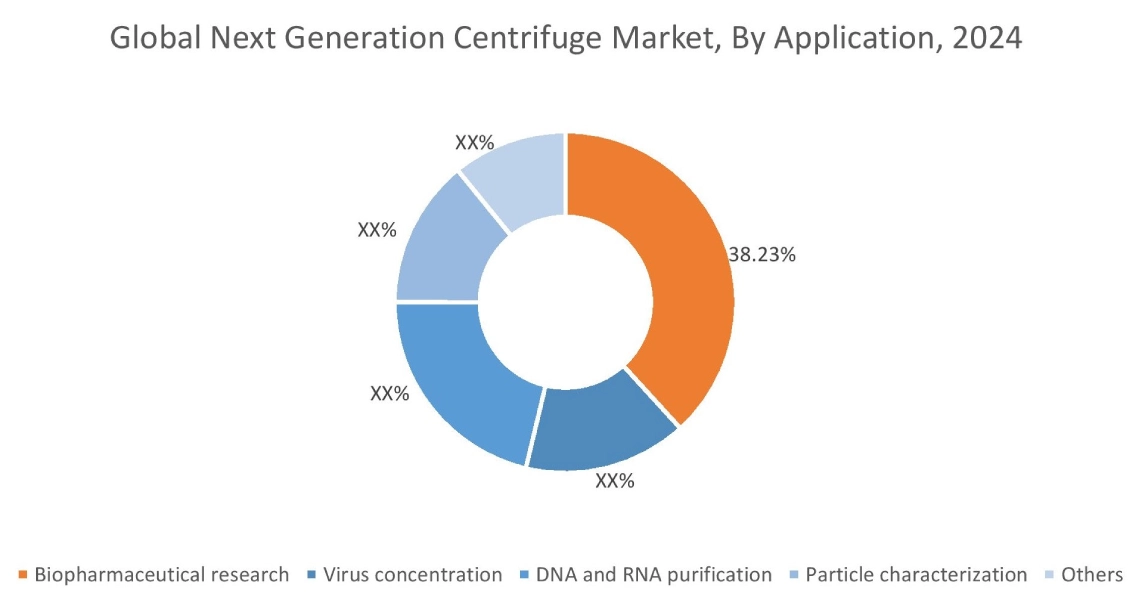
By End User:
Based on the end user, the market is segmented into hospitals, pharmaceutical companies, academic and research institutions, food and beverage, and others.
Trends in the end user:
- Increasing adoption of next generation centrifuge in hospitals to separate body fluids is driving the market.
- Rising adoption of next generation centrifuge in pharmaceutical companies for isolating active pharmaceutical ingredients is driving the market growth.
Pharmaceutical companies accounted for the largest revenue share in the year 2024.
- Centrifuge machines are being increasingly utilized in pharmaceutical companies during drug formation and quality control due to efficient removal of impurities in the drugs.
- Moreover, the rising growth experienced by the pharmaceutical sector due to aging population and technological advancements is driving next generation centrifuge market demands.
- For instance, according to the Department of Pharmaceuticals, the Indian Pharmaceutical sector ranks third worldwide by volume of production.
- According to the next generation centrifuge market analysis, the rising adoption of centrifuges in pharmaceutical companies due to use in drug formation and quality control is propelling the next generation centrifuge industry during the forecast period.
Hospitals is anticipated to register the fastest CAGR during the forecast period.
- Centrifuges are used to examine and separate components of blood namely red blood cells and white blood cells which drives the segment.
- Further, the increasing utilization of next generation centrifuge in clinics for immunology through efficient separation is driving the market.
- Moreover, there has been a rise in the number of small clinics and diagnostic centers due increased awareness of preventative healthcare among the people which is driving the next generation centrifuge market demand.
- For instance, according to Bajaj Finserv, the diagnostics market is mainly composed of pathology and radiology and pathology makes up about 58% of the entire sector’s revenue. Centrifuges have experienced a rising adoption in the pathology labs which is driving the market.
- Therefore, the increasing demand for centrifuges in hospitals to examine components of the blood and studying immunology is driving the next generation centrifuge market size.
Regional Analysis:
The regions covered are North America, Europe, Asia Pacific, the Middle East and Africa, and Latin America.
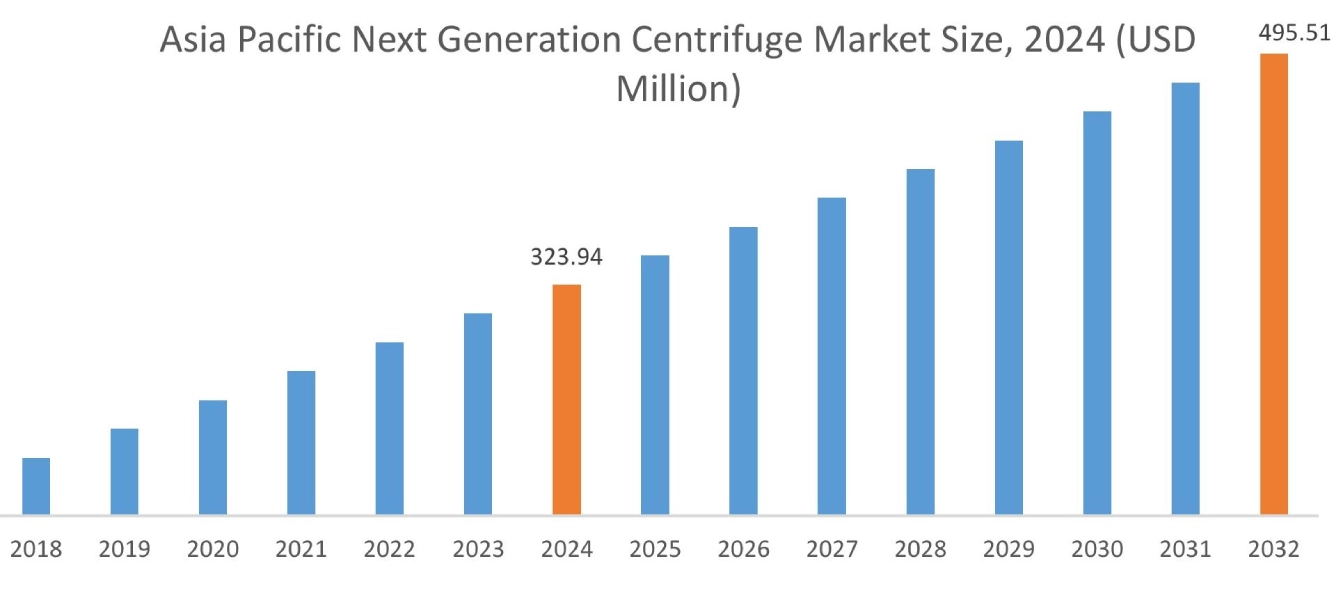
Asia Pacific region was valued at 323.94 Million in 2024. Moreover, it is projected to grow by 335.36 Million in 2025 and reach over 495.51 Million by 2032. Out of this, China accounted for the maximum revenue share of 35.8%. As per the next generation centrifuge market analysis, the growth in the Asia-Pacific region is primarily driven by the rising utilization of refrigerated centrifuges and increasing investments by pharmaceutical companies in R&D.
- For instance, Lupin Limited spent approximately Rs. 15,264 million in R&D in FY24. The increased R&D spending is expected to boost the market as the centrifuges are utilized in pharma companies for drug formulation and quality control.
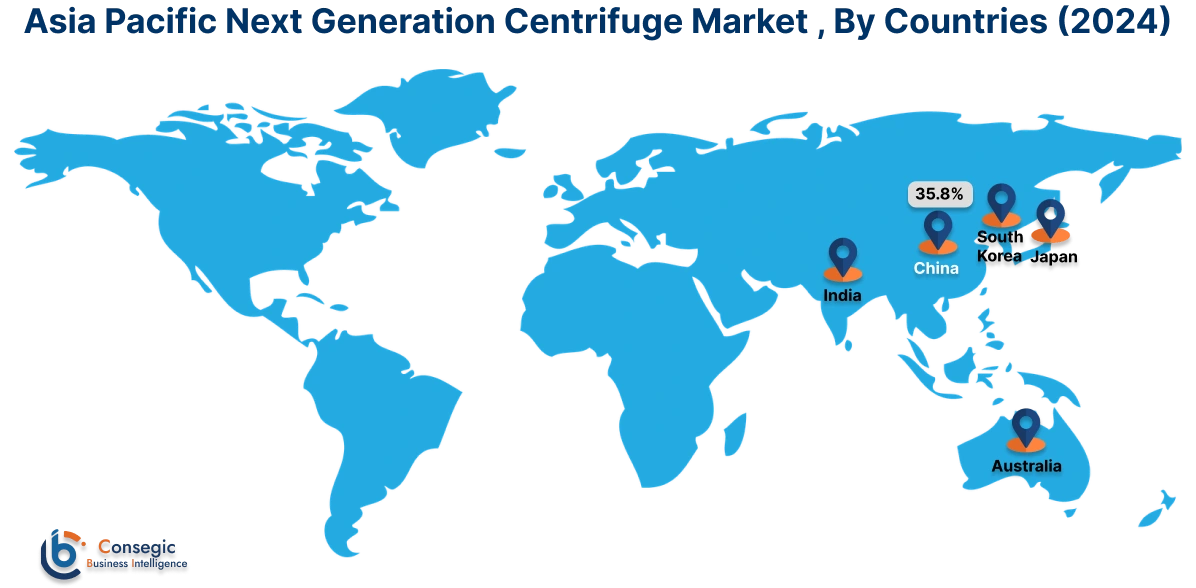
North America is estimated to reach over USD 553.61 Million by 2032 from a value of USD 377.08 Million in 2024 and is projected to grow by USD 389.01Million in 2025. In North America, the growth of next generation centrifuge industry is driven by the increasing adoption of centrifuges by pharmaceutical companies. Moreover, the increasing investments in the production and distribution of key raw materials used in centrifuges have resulted in the rise of next generation centrifuge market share.
- For instance, according to the American Iron and Steel Institute, in the week ending on May 2025, the domestic steel production in the U.S. was approximately 1,740,000 net tons which is an increase of 1.8 percent increase compared to the same period last year. The growing emphasis on domestic steel production is expected to boost the market as steel plates are utilized in the cabinets of centrifuges for increased protection.
Additionally, the regional analysis depicts that the growing investment in healthcare is driving the market demand in Europe. Furthermore, as per the market analysis, the market demand in Latin America is expected to grow at a considerable rate due to increased spending on pharmaceutical drugs. Middle East and African regions are expected to grow at a considerable rate due to factors such as a growing number of academic institutes and a rise in the number of hospitals among others.
Top Key Players and Market Share Insights:
The global next generation centrifuge market is highly competitive with major players providing solutions to the national and international markets. Key players are adopting several strategies in research and development (R&D), product innovation, and end-user launches to hold a strong position in the next generation centrifuge market. Key players in the next generation centrifuge industry include-
- Horiba Group (Japan)
- Haier Biomedical (China)
- Andreas Hettich GmbH (Germany)
- QIAGEN (Netherlands)
- ALFA LAVAL (Sweden)
- Thermo Fischer Scientific (U.S.)
- Eppendorf SE (Germany)
- Beckman Coulter, Inc (U.S.)
- Sartorius AG (Germany)
- NuAire, Inc. (U.S.)
Recent Industry Developments :
- In January 2025, VFL Sciences, a provider of advanced centrifuges, announced a collaboration with RocGene Technology that allows RocGene to sell its products in India through VFL Sciences. The collaboration is a multiyear agreement that enables both companies to explore the Indian market and implement strategies that further strengthen their presence.
- In March 2025, Thermo Fisher Scientific Inc. announced the launch of three floor-model centrifuges called the thermos scientific cryofuge, thermos scientific BIOS, and thermos scientific LYNX. The centrifuges feature a sustainable and natural refrigerant cooling system that is compliant with European Union and United States Environmental Agency F-gas regulations.
Next Generation Centrifuge Market Report Insights :
| Report Attributes | Report Details |
| Study Timeline | 2019-2032 |
| Market Size in 2032 | USD 1,734.37 Million |
| CAGR (2025-2032) | 5.2% |
| By Product Type |
|
| By Application |
|
| By End User |
|
| By Region |
|
| Key Players |
|
| North America | U.S. Canada Mexico |
| Europe | U.K. Germany France Spain Italy Russia Benelux Rest of Europe |
| APAC | China South Korea Japan India Australia ASEAN Rest of Asia-Pacific |
| Middle East and Africa | GCC Turkey South Africa Rest of MEA |
| LATAM | Brazil Argentina Chile Rest of LATAM |
| Report Coverage |
|
Key Questions Answered in the Report
How big is the next generation centrifuge market? +
The next generation centrifuge market is estimated to reach over USD 1,734.37 Million by 2032 from a value of USD 1,185.09 Million in 2024 and is projected to grow by USD 1,222.25 Million in 2025, growing at a CAGR of 5.2% from 2025 to 2032.
Which is the fastest-growing region in the next generation centrifuge market? +
Asia-Pacific region is experiencing the most rapid growth in the next generation centrifuge market.
What specific segmentation details are covered in the next generation centrifuge market report? +
The next generation centrifuge market report includes product type, application, end user and region.
Who are the major players in the next generation centrifuge market? +
The key participants in the next generation centrifuge market are Horiba Group (Japan), Haier Biomedical (China), Thermo Fischer Scientific (U.S.), Eppendorf SE (Germany), Beckman Coulter, Inc (U.S.), NuAire, Inc. (U.S.), Andreas Hettich GmbH (Germany), QIAGEN (Netherlands), ALFA LAVAL (Sweden), Sartorius AG (Germany), and Others.
